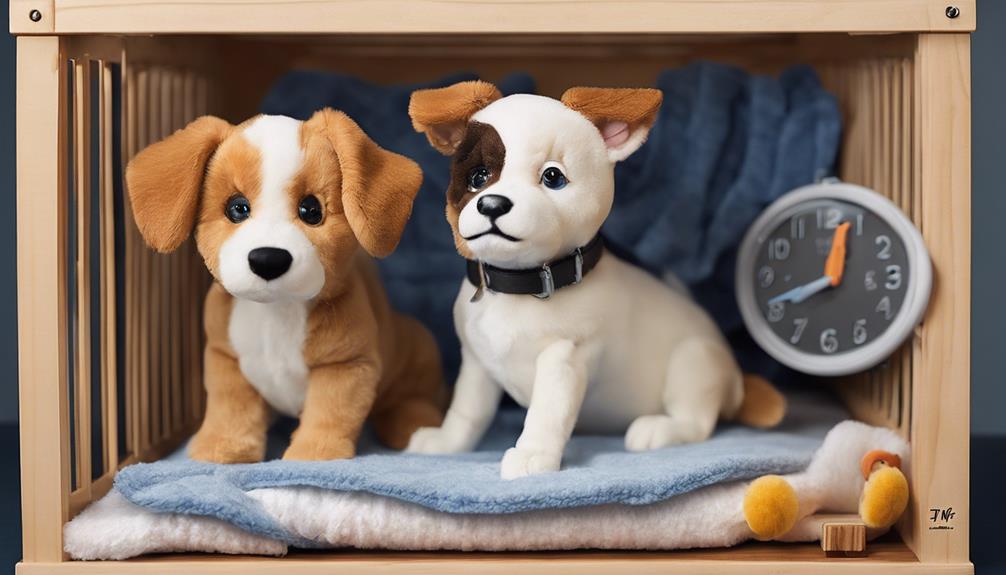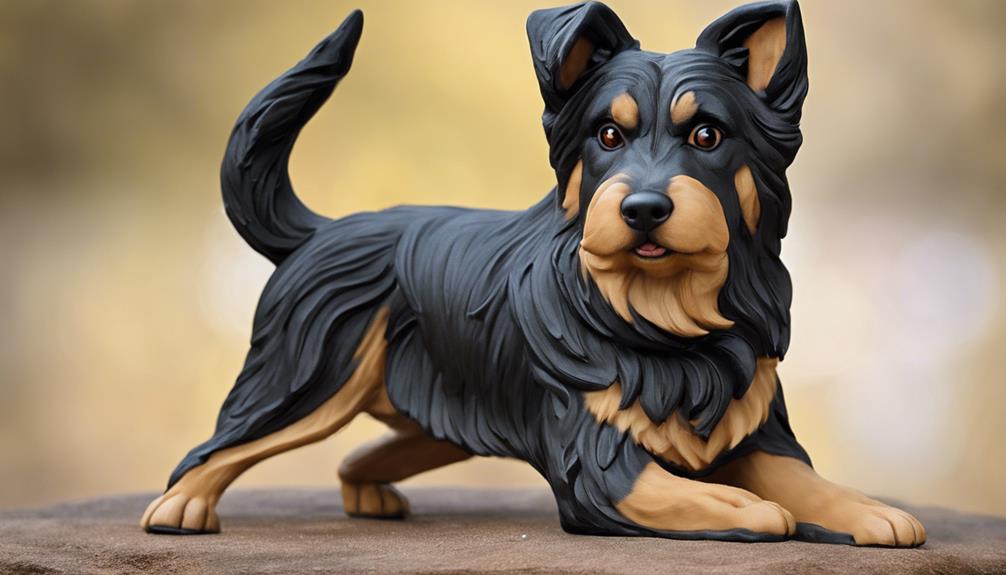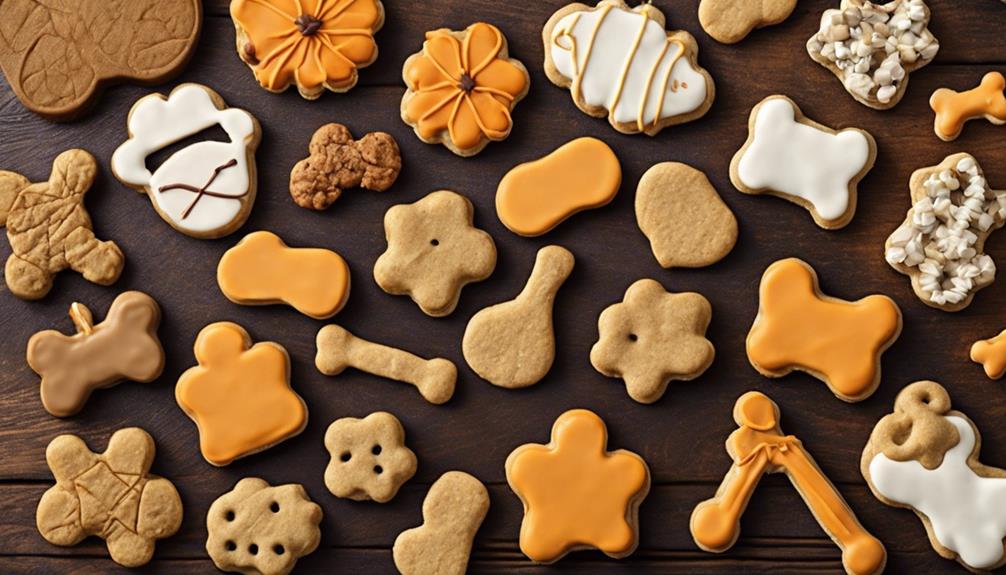To ensure successful puppy crate training, begin by selecting the appropriate size crate based on your pup’s weight and projected size. Establishing a structured routine that incorporates meals, potty breaks, playtime, and training sessions will aid in their adjustment. Utilize positive reinforcement, such as treats and praise, to promote good behavior and strengthen the bond between you and your puppy. When preparing the crate, make it comfortable with bedding and toys, and gradually introduce the space to your puppy. During nighttime and alone time training, practice patience, ignore unnecessary whining, and gradually increase the duration of alone time. Consistency and patience are essential for effective crate training for your furry companion.
Key Takeaways
- Gradually introduce puppy to crate for short periods daily.
- Use positive reinforcement like treats and praise during crate training.
- Establish a structured routine for meals, potty breaks, playtime, and rest.
- Choose the right crate size based on puppy's weight and size.
- Adapt crate training schedule based on puppy's age, needs, and behavior cues.
Benefits of Crate Training for Puppies
Crate training for puppies offers a multitude of benefits that contribute to their overall well-being and development. It provides a secure environment resembling a den where puppies feel safe and comfortable. This structured training aids in establishing a routine, like a potty training schedule, which is important for developing bladder control. By using positive reinforcement methods, such as treats or praise, puppies learn desired behaviors and build a strong bond with their owners. The crate also serves as a tool to prevent destructive behaviors, as puppies are less likely to chew on furniture or shoes when confined in their designated space.
Moreover, crate training can help reduce stress and anxiety in puppies by giving them a safe haven to retreat to when feeling overwhelmed. This practice promotes good habits and discipline while offering a sense of security. Overall, crate training plays a significant role in the holistic development of puppies, fostering a positive and enriching environment for their growth.
Choosing the Right Crate Size
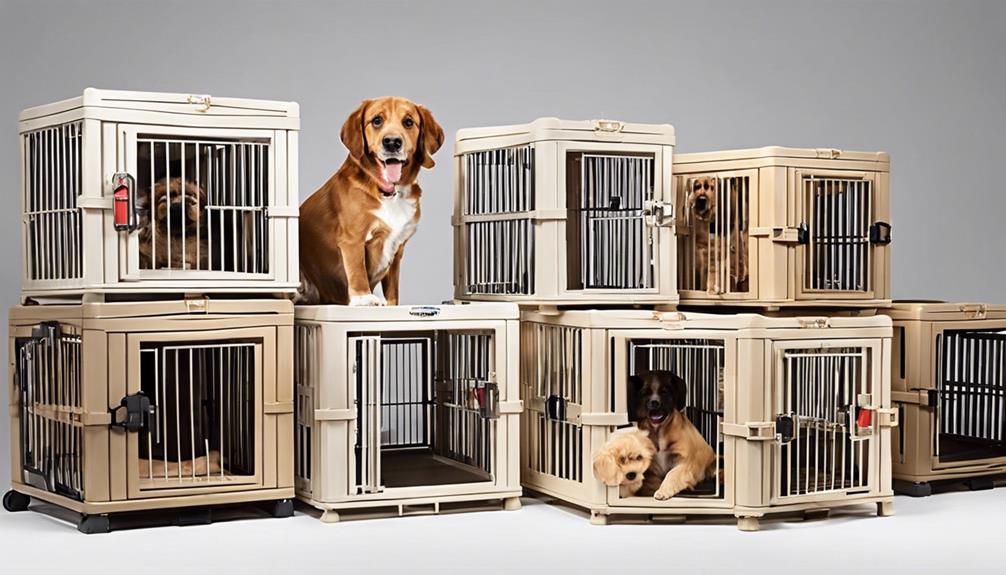
To guarantee your puppy's comfort and safety, it is important to choose a crate size that enables easy movement and relaxation. The crate should allow your puppy to stand up, turn around, and lie down comfortably. Selecting a crate that suits your puppy's adult size can prevent the need for replacements as they grow. It is recommended to choose a crate size based on your puppy's current weight and estimated adult size to make sure they feel secure and not cramped in the space. An appropriately sized crate is essential for proper crate training. Here is a table to help you determine the right crate size for your puppy:
| Puppy Weight | Estimated Adult Size |
|---|---|
| Up to 10 lbs | Small (Up to 25 lbs) |
| 10-25 lbs | Medium (25-50 lbs) |
| 25-50 lbs | Large (50-100 lbs) |
| 50-75 lbs | X-Large (100+ lbs) |
| 75+ lbs | XX-Large |
Establishing a Structured Routine
To establish a structured routine for your puppy's crate training, focus on planning a daily schedule that includes specific times for meals, potty breaks, playtime, and rest.
Consistency in your training schedule is key to helping your puppy anticipate and adapt to their routine effectively.
Daily Routine Planning
Establishing a structured routine for your puppy involves planning specific times throughout the day for meals, potty breaks, playtime, and crate training sessions. To guarantee success in the crate training process, follow these guidelines:
- Feeding Schedule: Offer meals at consistent times to regulate potty breaks.
- Potty Breaks: Take your puppy outside after meals, playtime, and waking up.
- Playtime: Engage in interactive play to burn energy and strengthen the bond.
- Crate Training Sessions: Include short periods in the crate to acclimate your puppy gradually.
Adapt the schedule based on your puppy's age, needs, and behavior cues. Consistency and predictability will help your puppy feel secure and comprehend what to expect each day.
Consistent Training Schedule
Planning a vital training schedule for your puppy involves setting specific times for activities to create a structured routine. By adhering to a schedule, you provide your puppy with a sense of security and help them understand what is expected of them. This structured routine is essential for successful crate training and overall obedience. Below is a table outlining a sample training plan to help you establish a consistent schedule for your puppy:
| Time | Activity |
|---|---|
| 7:00 am | Morning walk |
| 8:00 am | Breakfast and playtime |
| 10:00 am | Training session |
| 12:00 pm | Lunch and rest |
| 3:00 pm | Afternoon walk |
Creating and sticking to a consistent training schedule will aid in house training and behavioral development.
Incorporating Positive Reinforcement Techniques
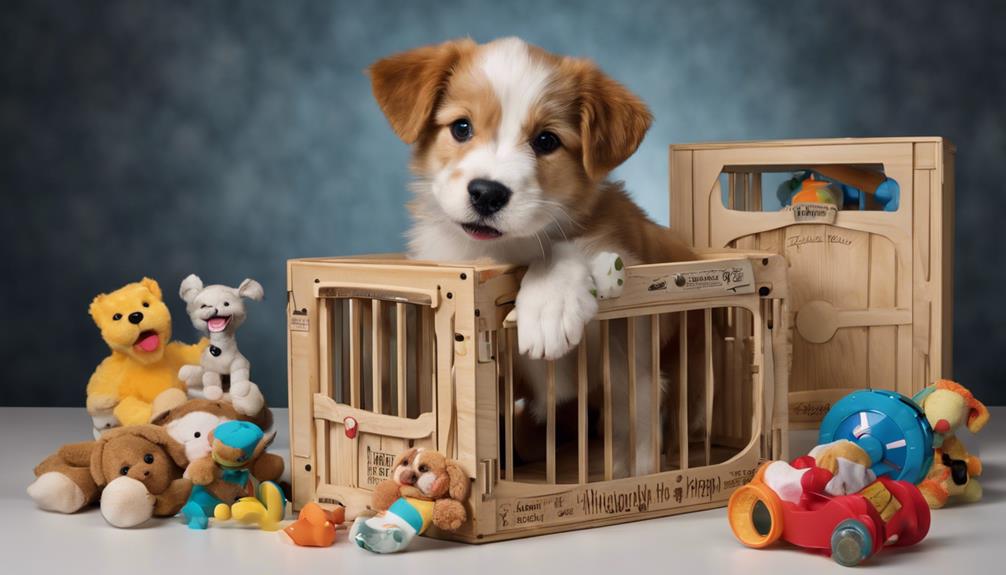
Considering the importance of creating a positive association with crate time, incorporate effective positive reinforcement techniques to enhance your puppy's training experience. Positive reinforcement techniques involve rewarding desired behaviors with treats or verbal praise to encourage repetition. This method helps your pup associate the crate with positive experiences, making it more likely to accept crate time willingly.
Verbal praise and treats are powerful tools for reinforcing good behavior during crate training sessions. By consistently using positive reinforcement, you can create a strong bond between you and your dog, making the training process more enjoyable and effective.
Crate Training Schedule by Age
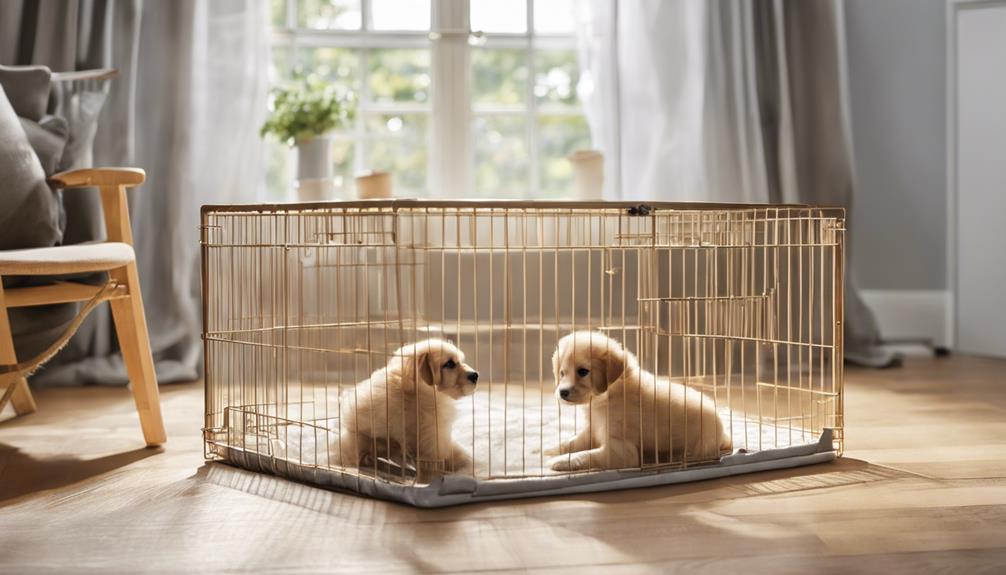
When crate training your puppy, it's essential to think about their age for effective results. Age-appropriate crate sizes guarantee comfort and safety for your growing pup.
Gradual introduction to the crate and maintaining a consistent daily routine are key factors in successful crate training.
Age-Appropriate Crate Sizes
Determining the appropriate crate size based on your puppy's age is essential for their comfort and safety during crate training. Here are the best crate sizes based on your puppy's age:
- 2-month-old puppy: 24'L x 18'W x 21'H
- 4-month-old puppy: 30'L x 19'W x 21'H
- 6 months: 36'L x 23'W x 25'H
- 8-month-old puppy: 42'L x 28'W x 30'H
Ensuring your puppy has enough space to stand, turn around, and lie down comfortably is vital for effective crate training. As your puppy grows, providing an age-appropriate crate size will help them feel secure and promote positive associations with their crate. Remember, the right crate size contributes significantly to a successful crate training journey.
Gradual Crate Introduction
To facilitate a smooth introduction to crate training, gradually acclimate your puppy to their crate as a positive and safe haven. Begin by placing the crate in a common area where your puppy spends time, allowing them to explore it at their own pace. Encourage them with treats and toys to create a positive association with the crate.
Depending on your puppy's age, adjust the schedule to gradually increase the time spent in the crate. This gradual introduction helps your puppy feel comfortable and builds their confidence, setting the stage for successful training sessions.
Consistent Daily Routine
Establishing a consistent daily routine is essential for effective crate training, tailored to your puppy's age and developmental stage. When it comes to a puppy crate training schedule, younger puppies require more frequent potty breaks and play sessions, while older puppies may need longer periods of rest and structured training sessions. Following a specific routine helps establish a sense of security and stability for your furry companion.
Make sure to adjust the schedule to cater to the needs of your puppy, whether they're younger or older. Consistency is key in creating a structured environment that promotes learning and comfort for your puppy. Stick to the routine to help them feel safe and secure in their crate.
Tips for Successful Crate Training
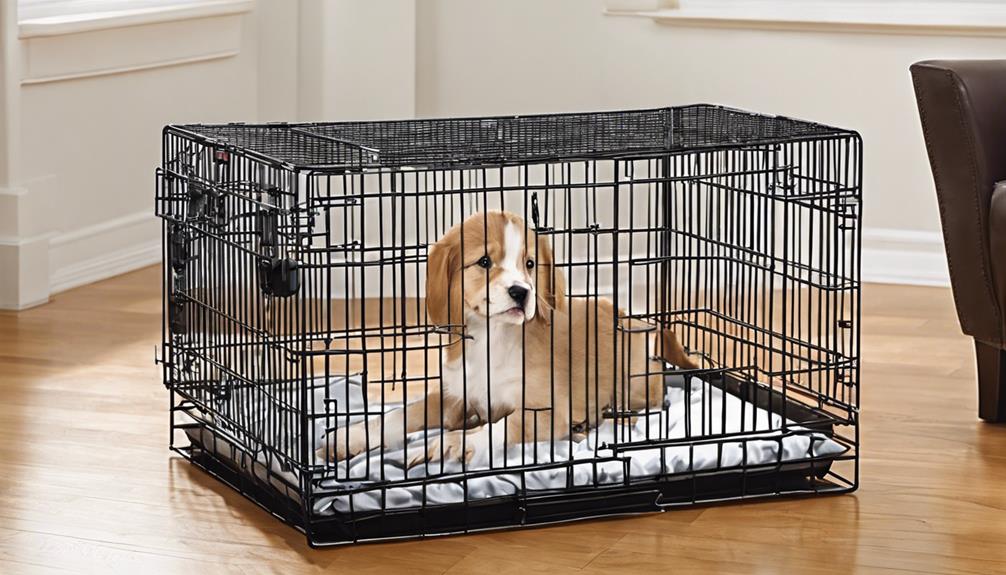
For successful crate training, consistency and positive reinforcement are key to helping your puppy feel secure and comfortable in their crate. Start early to introduce your puppy to the crate as a cozy space by using comfortable bedding and providing toys for entertainment. Use positive reinforcement techniques such as treats and praise to encourage your puppy to enter the crate willingly.
Gradually increase the duration of crate time to help your puppy adjust to being crated for longer periods. Establish a consistent schedule for crate training sessions to create a routine that your puppy can rely on. By making the crate a welcoming environment and incorporating positive experiences, your puppy will learn to see the crate as a safe and comfortable space.
Frequently Asked Questions
What Is a Good Crate Training Schedule for Puppies?
For a successful crate training schedule for your puppy, focus on regular bathroom breaks, playtime, meals, and rest. Integrate short crate sessions to introduce the crate gradually. Establish a routine that combines repetition and rest to help your puppy adapt effectively.
How Many Hours a Day Do You Crate Train a Puppy?
You should crate train a puppy for his age in months plus one hour. This guideline helps prevent accidents and promotes positive behavior. Adjust crate time as needed based on the puppy's signals. Be attentive to his needs.
How Often Should You Let a Puppy Out of a Crate?
You should let a puppy out of the crate every 2-4 hours during the day. Younger pups may need more frequent breaks, even at night. Remember, the rule of thumb is the puppy's age in months plus one hour for max crating time.
How Long Can You Leave a 8 Week Old Puppy in a Crate?
You should not leave an 8-week-old puppy in a crate for more than 2-3 hours at a time. Their bladder control is limited, so frequent bathroom breaks are essential. Follow the age in months plus one guideline to prevent accidents and guarantee comfort.
Is There a Best Time to Start Crate Training My Puppy?
Yes, there is an ultimate puppy crate training schedule to help you start the process at the best time. Begin as soon as you bring your puppy home. Consistency is key when establishing a routine, so follow the ultimate puppy crate training schedule for successful results.
Conclusion
To summarize, crate training is an essential tool for helping your puppy adapt to their new environment and learn important behaviors. By following a structured schedule, using positive reinforcement techniques, and choosing the right crate size, you can set your puppy up for success.
For example, a case study showed that a 10-week-old puppy quickly learned to love their crate and feel safe and secure inside it, thanks to consistent training and positive reinforcement.
Remember, patience and consistency are key to successful crate training!
